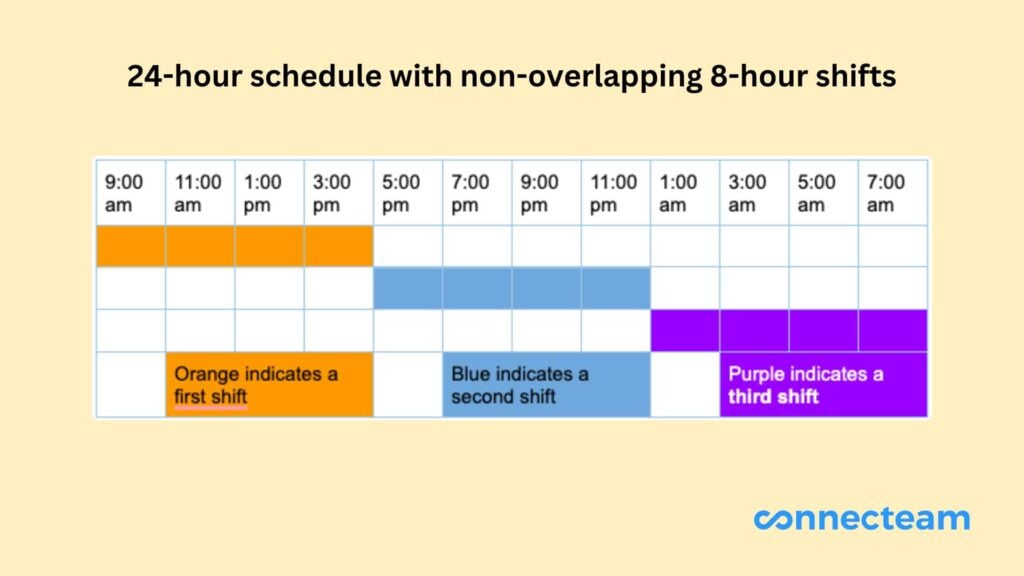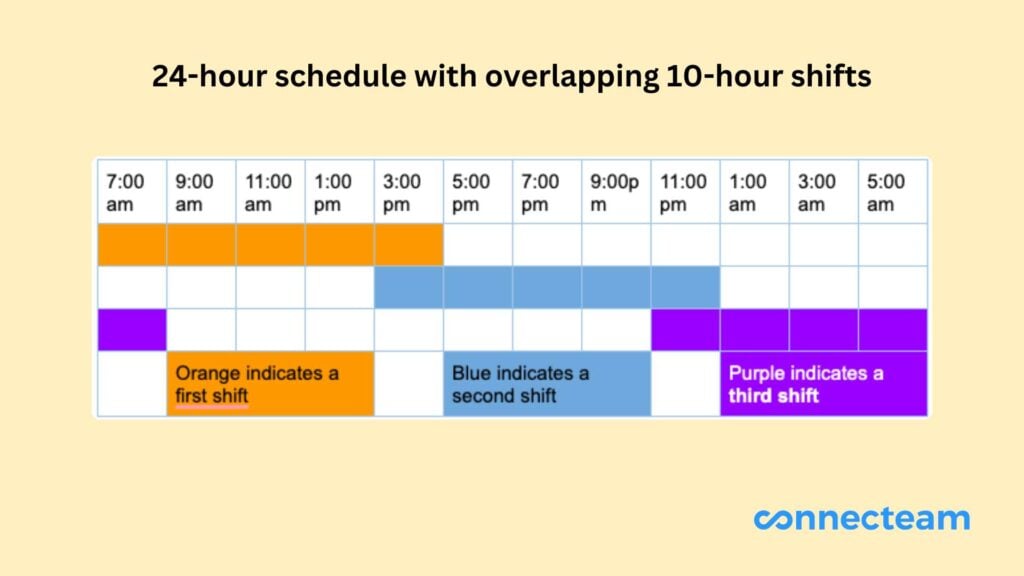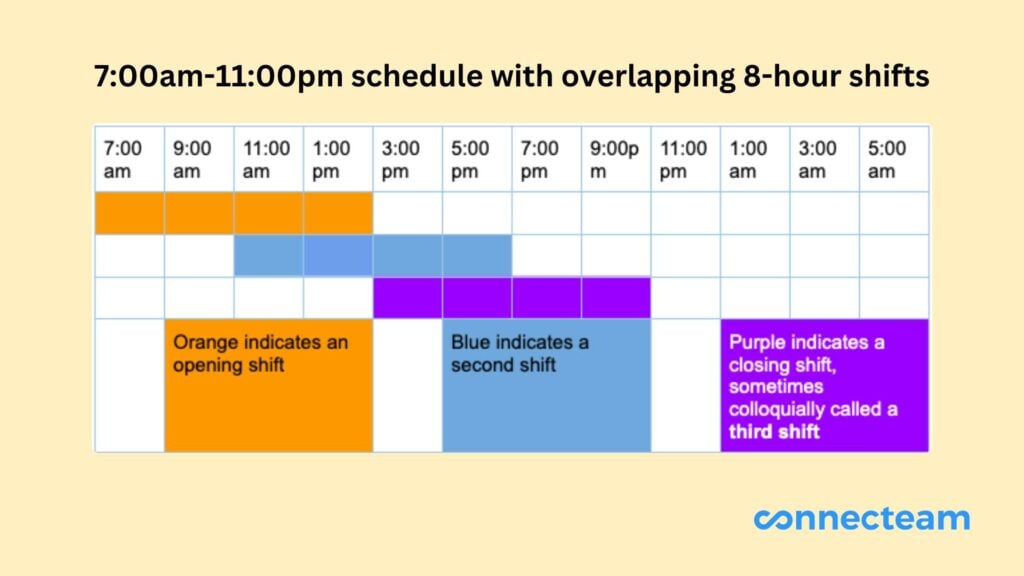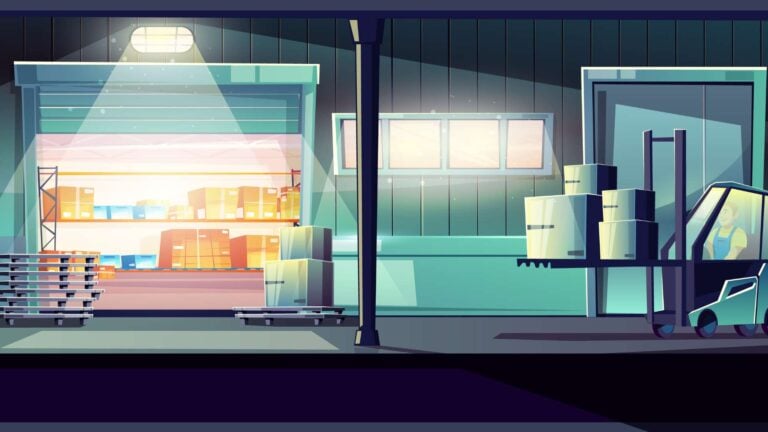The third shift is sometimes called graveyard work because it refers to work hours that occur overnight into the early morning. This guide dives into the pros and cons of the third shift and discusses which industries commonly use this shift.
For some businesses, maintaining productivity around the clock is essential. The third shift, sometimes called night shift or graveyard shift, steps in to meet this need. But implementing this shift can be difficult because of employee reluctance, oversight issues, and more.
In this article, we consider the pros and cons of third shift work and provide practical tips for businesses looking to implement third shifts for the first time.
Key Takeaways
- Third shift employees work night-time hours into the early morning.
- Industries with 24/7 operations—including those that serve public health and safety needs—are the most likely to have third shift employees.
- The third shift can help businesses increase productivity, but it presents oversight and employee health challenges.
What Is the Third Shift? Hours and more
Sometimes ominously referred to as the graveyard shift, the third shift refers to nighttime shifts that occur after first and second shifts.
Companies that choose to incorporate a third shift job are often hoping to maximize productivity by operating 24/7 or catering to international customer needs across time zones. The third shift is also sometimes used on a limited basis by companies that need overnight security or other services.
Third shifts can vary in length but are commonly 8-10 hours.
What time is the third shift?
A typical third shift schedule starts around 11:00 pm-1:00 am and ends around 7:00 am-9:00 am. However, exact third shift hours can vary based on the company and industry.
Did You Know?
Any shift that follows a second shift might be called a “third shift,” even if that shift doesn’t occur overnight. For example, a restaurant shift that ends at midnight before the business closes might be labeled a third shift. However, the term “closing shift” is most commonly used in industries where such shifts conclude daily business operations. The term “third shift” typically refers to overnight shifts in 24-hour schedules.
Third Shift Examples



Industries Using Third Shifts
Several industries make use of third shift scheduling, including:
- Healthcare. Hospitals, emergency medical care, and long-term nursing care facilities routinely need overnight staff.
- Manufacturing. Factories sometimes run their operations 24/7 to meet demand.
- Logistics. Warehouses, shipping companies, and delivery services use third shifts to minimize the time needed to deliver products.
- Safety. This includes public services like police and fire departments, as well as private security services.
- Customer support. Businesses that may not open outside traditional business hours sometimes still employ third shift workers to support customers around the globe.
Third Shift Benefits
Benefits for employers
Employers draw many benefits from third shift work, including:
- Global reach. Businesses serving global markets can significantly enhance their customer service offerings by operating a third shift. Round-the-clock availability can lead to improved customer satisfaction.
- Improved crisis response. With employees working all hours of the day and night, employers are better able to respond to emergencies quickly. Whether there’s a technical problem or a security breach, someone is there to handle it.
- Better use of resources. By running operations continuously, employers can use equipment and facilities more efficiently. This can reduce downtime and prevent bottlenecks that take days to resolve.
Did You Know?
Connecteam’s team instant messaging features help employees stay connected, even when they’re working outside traditional hours.
Benefits for employees
Working the night shift isn’t for everyone, but some employees prefer it. Some of their reasons include:
- Quieter work environment. Working nights can come with quieter spaces and less interpersonal interactions for those who prefer solitude.
- Higher income potential. Many employers offer incentive pay to employees on the third shift. Some union agreements even require this.
- Traffic avoidance. Heading to work in the late evening often avoids most commuting traffic jams. Employees on the third shift often enjoy shorter commuting times overall.
One third shift employee wrote, “I love it. Not a lot of customers , alot of free time during the day once i wake up.”
Third Shift Challenges
While beneficial to many, the third shift can sometimes be difficult to navigate.
Challenges for employers
Employers often encounter difficulties staffing their third shifts effectively and ensuring adequate supervision during these hours.
- Recruitment and retention. Attracting workers for night shifts can be difficult, and third shift employees tend to have a higher turnover rate than day shift workers.
- Management oversight. Third shift supervisor work can also be less desirable for employees, adding to the challenge to have adequate staffing for all hours. Ensuring supervision meets business needs takes careful planning.
- Work quality. Maintaining work quality through the night isn’t always possible. For example, a recent study published in Nursing Open found that nurses working at night were more likely to encounter patient safety issues and suffer physiological consequences than those working during the day. Employees working while their body expects to sleep are more prone to make mistakes and miss key information.
- Hours tracking. The third shift often uses less staff than day shifts do. With less oversight in place, it becomes even more important for businesses to monitor and record non-exempt employees’ work hours correctly for accurate payroll.
- Union agreements. Many industries that rely on third shifts also employ union-represented workers. Union agreements place contractual obligations on the employer that must be met for all workers, including provisions that apply specifically to third shifts.
- Laws and regulations. Employers must be aware of any laws or regulations that impact third shift scheduling. These include meal and rest break laws, predictive scheduling laws, overtime laws, and more.
While these challenges are significant, there are steps that can mitigate their impact. Incentive pay like shift differentials can help draw more employees to third shift work. Staying proactive in your planning helps keep oversight to avoid quality dips. Putting reliable systems in place will keep you on track to accurate payroll and contract compliance. Finally, seeking legal counsel can help you stay on top of any laws that apply to your business.
Did You Know?
Connecteam makes creating work schedules and tracking hours simple, no matter what time your employees are working.
Challenges for employees
- Health problems. Modifying sleep patterns continually can impact employees’ circadian rhythms like SWSD (Shift Work Sleep Disorder) and has been linked by the National Institute of Health to health risks including obesity, diabetes, mood disorders, and cancer.
- Safety. Some criminal acts, like robbery, are more likely to occur at night. For instance, convenience stores open 24/7 are more likely to be robbed during late evening and early morning hours. While employers can take steps to ensure their workers are safe, there may be increased risks to employee safety during the third shift.
- Work-life balance. Maintaining personal relationships and managing household needs while working the third shift can be difficult. For example, one employee shared on Reddit that she has difficulty running errands after working third shift.
This Might Interest You
Read more about the best night shift schedules for the sleep and health of your employees.
How To Implement a Third Shift schedule
Follow these steps to get your business ready to implement a third shift.
Identify night work
Will you be running all business functions over 24 hours, or only some of them? What third shift hours will your business use? By identifying the exact work your business needs performed overnight, and the hours during which those operations will take place, you’ll be prepared to staff your third shift effectively.
Solicit employee interest
You may already have employees on your team that would enjoy third shift work. Clearly communicate which work will be performed overnight and any training or incentives employees can gain from volunteering for the new shift. Leave time to address employee feedback and concerns before pushing the new shift into operation.
Consider incentive pay
Offering higher pay for third shift work is a common practice. If finding adequate staff numbers to work your third shift is difficult, building in pay incentives can help bridge the gap. Offering other benefits—such as higher paid time off accrual or company perks—can also be useful incentives.
Train new hires
Unless you’re cutting back hours in other shifts, you’re likely going to be hiring new employees for the third shift. Ensure all new staff undergo thorough employee training and become familiar with their job duties and your overnight safety protocols. Integrating tenured employees with the new hires will help quality expectations stay consistent.
Create schedules
Decide whether your third shift employees will work only night hours or if you’ll rotate them between day and night shifts using rotating shifts.
Once you have a broad plan for how shifts will interact, start creating schedules. Ensure that you include overlap time if employees need to hand off duties from one shift to the next.
Did You Know?
You can create and adjust schedules easily with Connecteam’s shift scheduling. And our guide on how to create a rotating schedule can help.
Pro Tip
Want to give employees more flexibility with their schedules? Consider using a shift bidding or self-scheduling system.
Monitor and adjust
Plan ahead to review how the third shift is running once it’s been in place for a while. Check for signs of employee errors or safety concerns that may require intervention. Address any issues and make adjustments as needed. Don’t forget to consider your employees’ well-being, and check that they have the resources they need to perform to your expectations.
Pro Tip
Overtime for non-exempt employees can balloon on the third shift if you don’t have systems in place to monitor employee hours on a daily basis. Connecteam’s overtime management system is built right into the app. With it, you can track overtime automatically and receive notifications if a third shift employee starts accruing unapproved overtime.
Flexible Hour Patterns and Alternative Shift Patterns
Now that we’ve looked at what third shift entails, let’s review the other hours and shift patterns you may want to consider for your business.
Part-time
A part-time employee can work during any shift—but works less than full-time hours. Hiring third shift employees on a part-time basis is less common, but these workers can help fill in other parts of your schedule when extra support is needed. If your business experiences periodic spikes in demand, then part-time workers are useful to meet those needs.
Weekend only
If your business operates 7 days a week, then you might consider hiring some employees to work weekends only. Like third shifts, weekend shifts are often less desirable shifts for workers. Hiring employees looking for part-time work or a second job can fill weekend shifts that are otherwise difficult to fill. Hiring weekend-only workers also avoids scheduling conflicts in states like Illinois that require employees to have at least 1 day off per 7 days worked.
First shift
This shift runs during traditional business hours and is considered the “day shift.” Hours for the first shift traditionally run between 7:00 am and 6:00 pm.
Second shift
The second shift follows the first shift and often fills the time between day and night work hours. The start and end times for second shifts are more variable depending on whether businesses are operating a long work day or a 24-hour operation. Start times for second shifts are generally between 3:00 pm and 5:00 pm. Second shifts usually end between 11:00 pm and 1:00 am.
Split shifts
Sometimes employees work across multiple shifts in a day. A split shift divides a shift into 2 segments with a long period off in between. For example, an employee might work half of their day during the first shift, and then return for the late half of the second shift or the start of the third shift.
It’s important to be mindful of labor laws that require premium pay for split shifts. Split shifts can also run into legally required premium pay for “clopening”—working a closing shift followed by an opening shift.
This Might Interest You
Check out our state labor law guides to find which premium pay requirements exist in your state.
Fixed shifts
A fixed shift refers to a scheduling pattern. Employees with a fixed shift always work the same shift assignment. For example, if you hire third shift employees to a fixed shift, then you’d schedule them to work third shift hours only.
Pro Tip
Seek out guidelines from health experts and organizations when determining whether to use fixed or rotating shifts. For instance, check out the National Institute for Occupational Safety and Health’s recommendations on helping shift workers.
Rotating shifts
A rotating shift is the opposite of a fixed shift. Instead of working the same shift hours every week, employees work different shifts throughout a set period, such as weekly or monthly. The shift assignments vary based on business needs. Rotating shifts can be more challenging to schedule because they’re changeable, but this flexibility helps your business adapt to changing needs and employee availability.
Be mindful of the potential for negative health effects when employees regularly bounce between day and night work hours. While some variation can be helpful to employees, too much can lead to burnout or absenteeism.
This Might Interest You
Read our guide on 24-hour shift schedules to learn more about the fixed and rotating schedules you can use when incorporating a third shift into your operations.
The Bottom Line on Third Shifts
Adopting a third shift can enhance your operational capabilities. Whether you’re serving customers globally or securing your business locally, third shift employees can be a vital part of your staffing strategy.
While the third shift offers many benefits, incentivizing employees to accept third shift hours can be challenging. Scheduling third shifts can also be difficult.
With thoughtful implementation and ongoing system support, your business can reap the benefits of a third shift. You can rely on Connecteam to streamline your schedule planning, keep employees up to date, and so much more.




